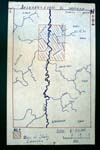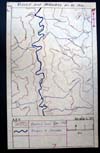|
Location Index
0.1 |
| Mubimambila Essays |
 |
 |
| Jumking, Chumtan Eric 1977 Sa'akaka, a Mambilla village in 1900 and 1976, a study in Historical Geography Department of Geography, Teacher's College, Mubi Unpublished Local Study |
Sarkaka near Mba: Kaka from Kimi about 20km to the S. 17 3 groups Sa'akaka, Nyong and Mamvok from Kimi, chose Wan to be admin centree, Mamvok for tribal feasts and Nyang for farming problems and orgn of hunting etc. So " Nkumsum" (chief of land) appointed at Nyang 53 Annual hunt late April in special area, elders go there fist to make medicine - public feast of all the game captured. Dancing and drinking on eve of the hunt, then "strategic juju beating" in the morning before set off - boys in pairs whip each other to show bravery - in special juju shrine so women can't see. Dancing continues for several days. Kati danced at weddings Chaam dance - men, women and children painted white and dance in a straight line 'under a leader who is himself terrifying to look at.' Lasts for c 2 days - first harvest of cocoyams and guineacorn. 2 caves allegedly dug to hide from white soldiers taking slaves. Juju experts alone make special medicines in special juju places for heavy crops etc. Female juju leaders go to same?? places to do witch hunting if there are many deaths in the village. 60 Gonu dance - 10-15 men go to lake during the night for trad. medicine - then return making lots of noises saying they have brought a big juju from the lake. "Later on dancing follows with almost every man having a curved neck calabash, with a hole at the end ...to make a terrifying noise to frighten the women." A similar activity happens during the 'kuru' dance. |
|
|
|
© Copyright 2006 Kent University & the Author |

